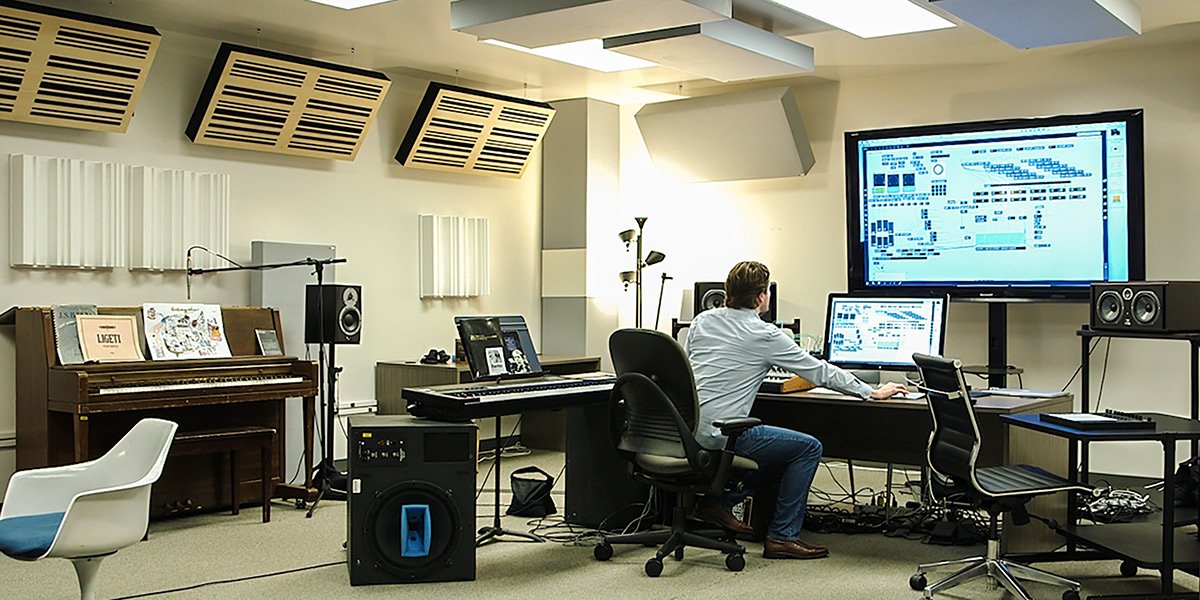
The renovated electronic music studio in the Fine Arts Building is so quiet you can hear a pin drop — or maybe not.
“I love how quiet it is in here,” says Ben Sabey, assistant professor of Music. “This room was specifically designed as a studio for electronic music. So when I close those double doors, I can play as loud as I want in here and if you’re in the hall, you can’t really hear anything.“
The classically trained musician and composer has been teaching composition, theory and electronic music at SF State since 2015. He says the studio’s acoustic treatments make it especially fantastic at absorbing sound in the space. A pin dropping is one sound he is unlikely to hear.
Each corner of the studio holds industry-standard equipment. The ceiling and walls are outfitted with professional-grade sound panels, except one.
“I like to call it the ‘egret studio’ because we have a mural of an egret, but I’m the only one who calls it that,” Sabey laughs. The School of Music commissioned a vibrant, floor-to-ceiling mural painted by Art alum Eli Lippert.
Breathing new life into old room
The room was not always used as a studio — or even a classroom.
“Before about a year ago, it was cluttered with all this old tech, but Sabey really spruced it up,” says Josh Susic, a senior majoring in music composition.
“The space had been neglected for many years,” Sabey admits, listing six old computers and keyboard as the only furniture more expensive than the tattered couch in the corner of the room.
“You see that computer over there?” he gestures. “That’s a Next computer, from the company Steve Jobs tried to start when he got fired from Apple.” He keeps it as a museum piece alongside a case of floppy disks.
At the time of Sabey’s hire, Daniel Bernardi, then interim dean of the College of Liberal & Creative Arts, was the administrative force behind the renovation. Bernardi wanted to augment the electronic music program to keep with student interests. He asked Sabey to propose a budget.
“[Bernardi] was extremely accommodating,” Sabey says. “It was a once-in-a-lifetime opportunity.”
Geeking over gear
Sabey shows off the most exciting gear in the room including a Moog Sub 37, a 12-inch Focal subwoofer, Focal Twin6 Be studio monitors, a Eurorack modular synthesizer, an Ableton Push 2 instrument, two Earthwork microphones and GIK acoustic panels.
To non-gearheads, the list is jargon and some of the equipment in the studio may look anything but cutting edge. That is because some are analog instruments re-creating authentic vintage sound, Sabey points out: “The Moog Sub 37 is a modern version of the Minimoog, which is a classic analog instrument was used by all kinds of great rock bands in the ’60s and ’70s. Moog is kind of the iconic name in synthesizers.”
“I really like the speakers,” Susic says about the Focal Twin6 Be monitors. “There are very limited spaces within the school where there is actual surround sound and electronic software to write music in surround sound.”
Sabey says the tweeters are top-of-the-line because they are made out of beryllium: “It’s a very light, thin metal. With a tweeter, you need a material that’s as light and as thin as possible to reproduce those high-frequencies, so it’s a very high-quality monitor.”
The Ableton Push 2 may catch the attention of students interested in producing loops, sounds and sequences in a live setting as many professional DJs do.
If that equipment fails to get students excited, perhaps the studio’s 80-inch television and new iMac will — the School plans to purchase one after it is released later this year.
‘Students from any background are welcome here’
Although the name can mislead, the electronic music studio is not simply used to produce EDM, or Electronic Dance Music. Courses do include EDM, but the studio is an experimental space for all genres.
“Some people like to take pride in their elitism and how refined their taste is,” Sabey says, “and I like to take pride in how omnivorous my tastes are.”
“Students from any background are welcome here,” Sabey adds. He is developing a Bachelor’s degree option for students who may not have formal musical training, but have made music on their laptop. “We’re just trying to throw the doors as wide open as we can.”
This spring Sabey is teaching a survey of electronic music, orchestration and private lessons, but hopes to teach an experimental ensemble class soon.
Looking forward
This is just the beginning of several contemporary programs coming to the School of Music.
“I’ve become increasingly aware of what students are looking for. They’re interested in DJ, EDM production … but a lot of students are also interested in scoring for video games and scoring for film,” Sabey says.
The fall semester will bring new courses teaching video game and film score composition, experimental music and even a rock music ensemble course started by new faculty. These programs will invite more opportunities for cross-disciplinary collaboration and networking, especially with students in Cinema and Computer Science.
SF State’s School of Music offers education comparable to Bay Area music conservatories but at a much more affordable price, Sabey says. He believes the studio is only the launching point, predicting that students will flock to these programs once they discover the value.
“I think it will be a magnet for students who are serious about electronic music and who want to have a high-quality studio space … to really experiment with electronic music and to make new noises and make new music,” he says. “… [The studio is] just a great resource for exploration and creativity.”
— Gospel Cruz
Links
Video directed and edited by Gospel Cruz. Cinematography by Roger Habon. Photo: Professor Benjamin Sabey works in the electronic music studio. Photo by Gospel Cruz.